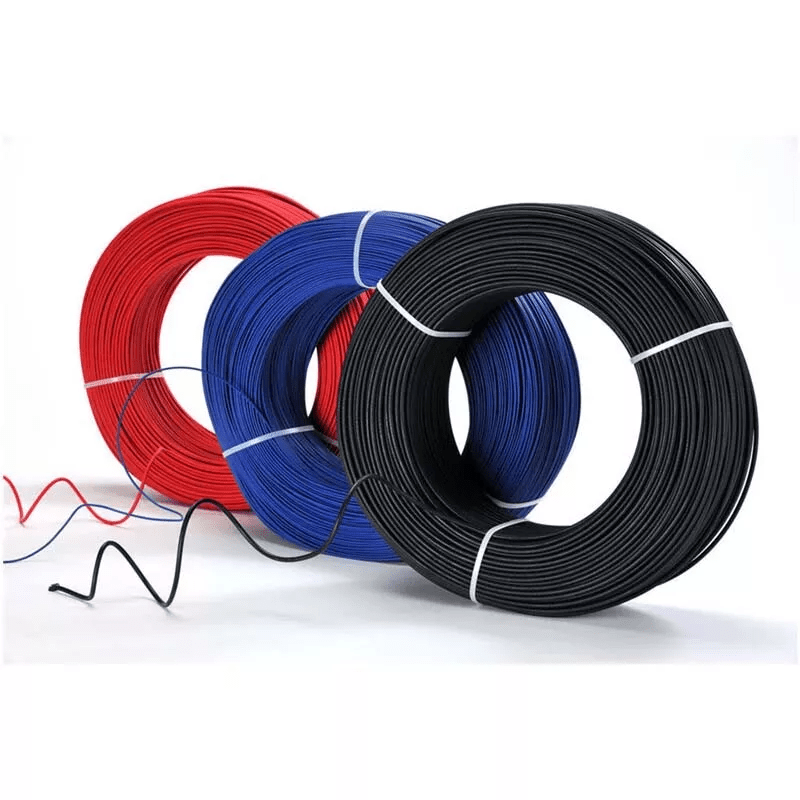1. Product core introduction
HomeDIYer offers flexible silicone stranded cable in 14/16/18/20/22/24/28/30 AWG and 5 distinctive colours. Manufactured in strict compliance with the UL3239 silicone wire standard, this cable is designed to provide a precise and safe electrical connection solution for DIY electronic projects, automotive modifications, and industrial equipment, making it an ideal choice for electrical wiring due to its excellent performance and reliable quality.
2. The main characteristics of the product
Multi-gauge AWG available: Covering a wide range of gauges from 14AWG to 30AWG, it meets the diversified needs of different electrical equipment for current carrying capacity. For example, in high-power industrial equipment, a thicker wire diameter of 14AWG - 18AWG may be required to ensure stable transmission of high current, while for some precision electronic instruments or small automotive electronic equipment, a thinner wire diameter of 28AWG - 30AWG is more suitable, allowing users to precisely match the wire diameter with the actual application scenarios to optimize the performance of the electrical system, avoiding the waste of resources and potential safety hazards.
High-quality silicone material: High-quality silicone is used as the insulating layer, which has excellent flexibility and can be easily bent and twisted, which is convenient for wiring operations in a variety of complex installation environments, whether it's a narrow space or the need for frequent bending parts, can be easily dealt with, effectively reducing the difficulty of the installation, and improve work efficiency. At the same time, the silicone material also has good resistance to high temperature and cold, can maintain stable physical and electrical properties in a wide range of temperatures, to adapt to the use of different environmental conditions, to ensure the long-term reliability and durability of the cable.
Advantage of stranded wire design: Stranded wire structure consists of multiple strands of fine copper wires stranded together, which not only enhances the flexibility of the cable, making it easier to operate and route, but also effectively improves the cable's resistance to stretching and bending, reducing the risk of the conductor breaking due to the external forces during use. In addition, the stranded structure compared to the solid conductor, in the high-frequency signal transmission has a better anti-electromagnetic interference ability, can ensure the stability of the signal transmission, improve the overall performance and stability of the electrical system.
3. Product use scene
DIY Electronic Projects: It can be used to connect circuit boards, power supplies, motors, sensors, and other components in homemade projects for electronics enthusiasts, such as homemade sound systems, small robots, and video game consoles. Its multiple AWG specifications can meet the requirements of different electronic components for current and signal transmission, the flexible silicone material is convenient for wiring in narrow electronic equipment enclosures to avoid squeezing or damaging other components, while the 5-color cables are easy to differentiate between the lines, which helps to quickly set up and debug the circuit, and to achieve the smooth production and operation of creative electronic works.
Car Modification and Repair: Reliable electrical connections are needed in car modification projects such as car audio upgrades, lighting modifications, and power seat installations. The cable's high-temperature resistance, flexibility and multi-specification characteristics enable it to adapt to the complex environment of the car's engine compartment and cabin, ensuring the stable transmission of power to various modification components. For example, in car audio modification, suitable AWG specifications can be selected according to the power requirements of amplifiers and speakers, and they can be connected through flexible silicone cables to avoid the sound quality effect being affected by improper wiring; in car lighting modification, its good insulation and anti-interference ability can ensure the stable operation of the lighting system, and enhance the personalisation and functionality of the car.
Industrial equipment manufacturing and maintenance: in the industrial automation production line, machinery and equipment, instrumentation and other industrial fields, used to connect the electrical lines between the motor, controller, sensors, displays and other equipment. It can withstand high temperature, vibration, electromagnetic interference and other harsh conditions in the industrial environment to ensure the normal operation of equipment and production continuity. For example, in automated production lines, UL3239 cables of different specifications can be used to transmit power supply, control signals and data signals respectively to meet the high precision and high reliability requirements of industrial equipment for electrical connections, while 5-colour cables help technicians to quickly identify and maintain the lines in the complex industrial wiring, improving production efficiency and the convenience of equipment maintenance.
Smart home system installation: In the installation and connection of smart home equipment, such as smart lights, smart curtain motors, smart cameras, smart sockets and other equipment between the power and signal transmission, the cable's flexibility and multi-specification features can meet the diverse needs of smart home system for wiring. Its good insulation performance and stability can ensure the reliable operation of smart devices, avoid equipment failure or signal interruption due to electrical problems, and provide users with a convenient, comfortable and safe smart home living experience.
4. Product use instructions
Preparation before installation:
Carefully check the appearance of the cable for defects such as breakage, scratches, stripped insulation, loose stranded wires, etc. If there are any problems, contact the supplier for replacement in time to ensure that the quality of the cables used is intact and undamaged. At the same time, according to the actual use of the scene and equipment connection requirements, determine the required cable AWG specifications and colours, and prepare the necessary installation tools such as wire strippers, crimping pliers, electrician's knife, insulating tape, heat-shrinkable tubing, etc., to ensure that the precision and applicability of the tools, so as to avoid damage to the cable in the installation process.
Wiring and connection:
In the wiring process, the cable should be reasonably planned according to the actual installation path and environmental conditions, avoiding excessive bending, twisting or stretching of the cable to prevent damage to the internal structure of the cable and affecting the electrical performance.
When connecting the cable to the equipment, first use wire strippers to carefully strip the insulation from the cable ends, then insert the copper wires into the connection terminals and firmly press them with crimping pliers to ensure a reliable connection and good contact. If a soldered connection is required, suitable solder and soldering techniques should be used to ensure that the solder joints are firm, smooth and free from false soldering. After the connection is completed, the connection is carefully insulated and can be wrapped with insulating tape or heat-shrinkable tubing to prevent leakage and short-circuit accidents.
Precautions for use:
The rated voltage and current of this cable should be used in strict accordance with the parameters on the product specification, and should not exceed the maximum value specified therein, so as not to cause electrical safety accidents, damage to equipment or personal injury. When connecting multiple devices, pay attention to calculating the total power and current to ensure that the cable can withstand the load.
Avoid exposing the cables to harsh environmental conditions such as high temperature, open fire, humidity, corrosive chemicals, etc. If it is unavoidable, corresponding protective measures should be taken, such as the use of fireproof, waterproof, corrosion-resistant wire troughs or casings to protect the cables, in order to prolong the service life of the cables and to ensure the stability of their performance.
Regularly check the connection parts and overall appearance of the cable to see if there is any looseness, oxidation, breakage, etc. If problems are found, they should be repaired or replaced in time to ensure the normal operation and electrical safety of the cable. At the same time, when carrying out equipment maintenance or overhaul, attention should be paid to the protection of cables to avoid damage caused by human factors.















